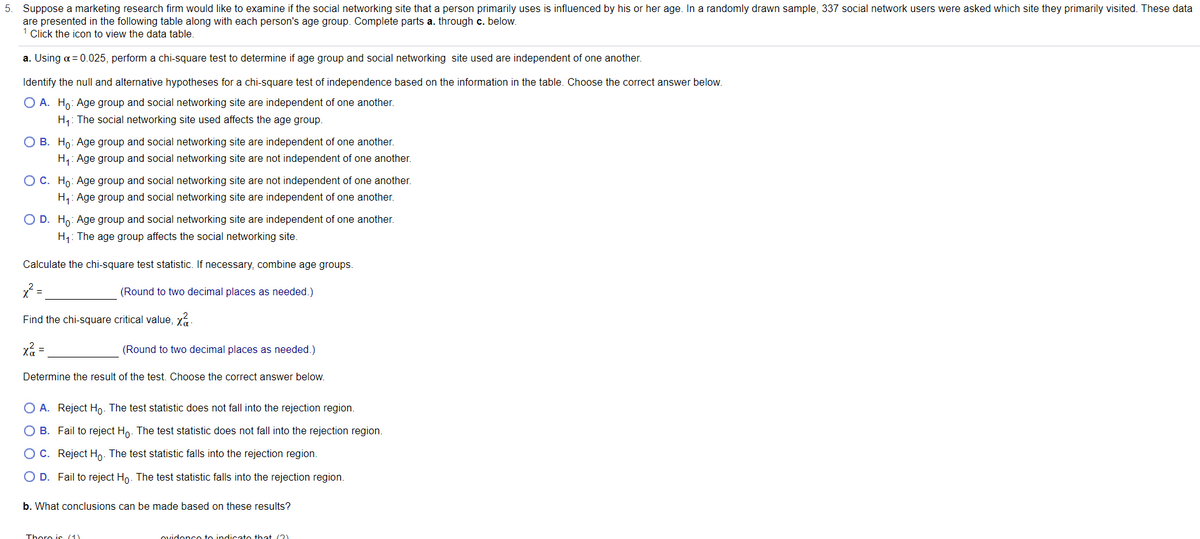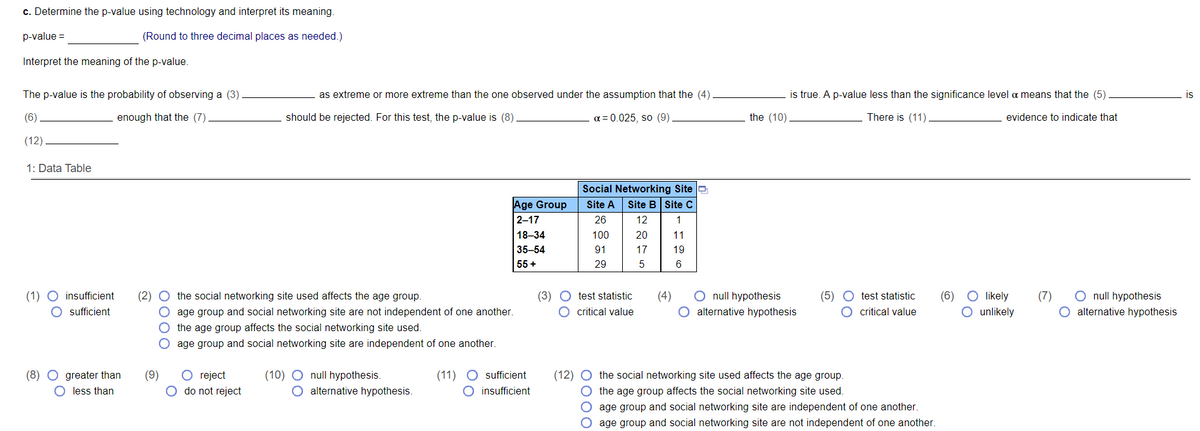Suppose a marketing research firm would like to examine if the social networking site that a person primarily uses is influenced by his or her age. In a randomly drawn sample, 337 social network users were asked which site they primarily visited. Thes are presented in the following table along with each person's age group. Complete parts a. through c. below. Click the icon to view the data table. a. Using a = 0.025, perform a chi-square test to determine if age group and social networking site used are independent of one another. Identify the null and alternative hypotheses for a chi-square test of independence based on the information in the table. Choose the correct answer below. O A. Ho Age group and social networking site are independent of one another. H,: The social networking site used affects the age group. O B. Ho: Age group and social networking site are independent of one another. H: Age group and social networking site are not independent of one another. OC. Ho Age group and social networking site are not independent of one another. H: Age group and social networking site are independent of one another. O D. Ho: Age group and social networking site are independent of one another. H: The age group affects the social networking site. Calculate the chi-square test statistic. If necessary, combine age groups. 2 = (Round to two decimal places as needed.) Find the chi-square critical value, x x = (Round to two decimal places as needed.) Determine the result of the test. Choose the correct answer below. O A. Reject Ho. The test statistic does not fall into the rejection region. O B. Fail to reject Ho. The test statistic does not fall into the rejection region. OC. Reject Ho. The test statistic falls into the rejection region. O D. Fail to reject Ho. The test statistic falls into the rejection region. b. What conclusions can be made based on these results?
Suppose a marketing research firm would like to examine if the social networking site that a person primarily uses is influenced by his or her age. In a randomly drawn sample, 337 social network users were asked which site they primarily visited. Thes are presented in the following table along with each person's age group. Complete parts a. through c. below. Click the icon to view the data table. a. Using a = 0.025, perform a chi-square test to determine if age group and social networking site used are independent of one another. Identify the null and alternative hypotheses for a chi-square test of independence based on the information in the table. Choose the correct answer below. O A. Ho Age group and social networking site are independent of one another. H,: The social networking site used affects the age group. O B. Ho: Age group and social networking site are independent of one another. H: Age group and social networking site are not independent of one another. OC. Ho Age group and social networking site are not independent of one another. H: Age group and social networking site are independent of one another. O D. Ho: Age group and social networking site are independent of one another. H: The age group affects the social networking site. Calculate the chi-square test statistic. If necessary, combine age groups. 2 = (Round to two decimal places as needed.) Find the chi-square critical value, x x = (Round to two decimal places as needed.) Determine the result of the test. Choose the correct answer below. O A. Reject Ho. The test statistic does not fall into the rejection region. O B. Fail to reject Ho. The test statistic does not fall into the rejection region. OC. Reject Ho. The test statistic falls into the rejection region. O D. Fail to reject Ho. The test statistic falls into the rejection region. b. What conclusions can be made based on these results?
Glencoe Algebra 1, Student Edition, 9780079039897, 0079039898, 2018
18th Edition
ISBN:9780079039897
Author:Carter
Publisher:Carter
Chapter10: Statistics
Section10.6: Summarizing Categorical Data
Problem 4BGP
Related questions
Question

Transcribed Image Text:5. Suppose a marketing research firm would like to examine if the social networking site that a person primarily uses is influenced by his or her age. In a randomly drawn sample, 337 social network users were asked which site they primarily visited. These data
are presented in the following table along with each person's age group. Complete parts a. through c. below.
Click the icon to view the data table.
a. Using a = 0.025, perform a chi-square test to determine if age group and social networking site used are independent of one another.
Identify the null and alternative hypotheses for a chi-square test of independence based on the information in the table. Choose the correct answer below.
O A. Ho: Age group and social networking site are independent of one another.
H1: The social networking site used affects the age group.
O B. Ho: Age group and social networking site are independent of one another.
H,: Age group and social networking site are not independent of one another.
O C. Ho: Age group and social networking site are not independent of one another.
H,: Age group and social networking site are independent of one another.
O D. Ho: Age group and social networking site are independent of one another.
H1: The age group affects the social networking site.
Calculate the chi-square test statistic. If necessary, combine age groups.
(Round to two decimal places as needed.)
Find the chi-square critical value, xa-
xã =
(Round to two decimal places as needed.)
Determine the result of the test. Choose the correct answer below.
O A. Reject Ho. The test statistic does not fall into the rejection region.
O B. Fail to reject Ho. The test statistic does not fall into the rejection region.
OC. Reject Ho. The test statistic falls into the rejection region.
O D. Fail to reject Ho. The test statistic falls into the rejection region.
b. What conclusions can be made based on these results?
Thoro is (1)
ovidonco to indicato that (2)

Transcribed Image Text:c. Determine the p-value using technology and interpret its meaning.
p-value =
(Round to three decimal places as needed.)
Interpret the meaning of the p-value
The p-value is the probability of observing a (3)
as extreme or more extreme than the one observed under the assumption that the (4)
is true. A p-value less than the significance level a means that the (5)
is
(6)
enough that the (7)
should be rejected. For this test, the p-value is (8)
a = 0.025, so (9)
the (10).
There is (11).
evidence to indicate that
(12)
1: Data Table
Social Networking Site O
Age Group
Site A
Site B Site c
2-17
26
12
1
18-34
100
20
11
35-54
91
17
19
55 +
29
6
O null hypothesis
O alternative hypothesis
O null hypothesis
(2) O the social networking site used affects the age group.
O age group and social networking site are not independent of one another.
O likely
O unlikely
(1) O insufficient
(3) O test statistic
(4)
(5) O test statistic
(6)
(7)
sufficient
O critical value
alternative hypothesis
O critical value
the age group affects the social networking site used.
age group and social networking site are independent of one another.
O reject
(10) O null hypothesis.
O alternative hypothesis.
(11) O sufficient
O insufficient
(12) O the social networking site used affects the age group.
(8) O greater than
O less than
(9)
do not reject
O the age group affects the social networking site used.
O age group and social networking site are independent of one another.
O age group and social networking site are not independent of one another.
Expert Solution
This question has been solved!
Explore an expertly crafted, step-by-step solution for a thorough understanding of key concepts.
Step by step
Solved in 3 steps with 6 images

Recommended textbooks for you

Glencoe Algebra 1, Student Edition, 9780079039897…
Algebra
ISBN:
9780079039897
Author:
Carter
Publisher:
McGraw Hill

Glencoe Algebra 1, Student Edition, 9780079039897…
Algebra
ISBN:
9780079039897
Author:
Carter
Publisher:
McGraw Hill